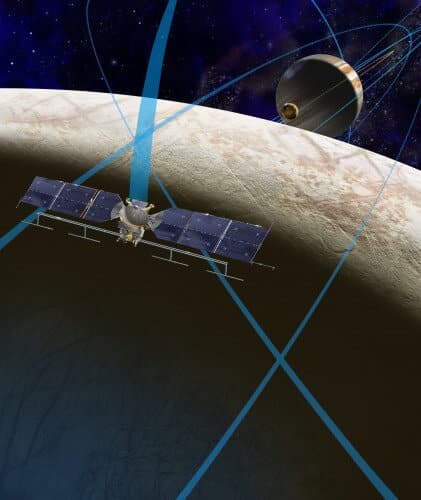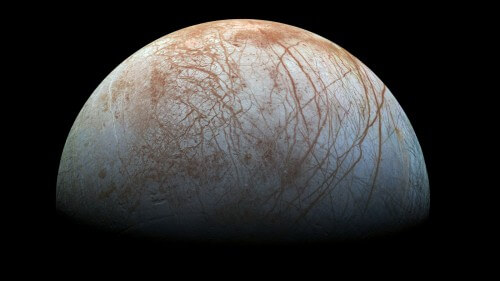The project is only in the initial phase of formation. Currently the launch is planned for 2022 * The goal is to confirm the existence and discover the characteristics of the subterranean ocean that some suspect is hidden beneath the ice sheet of Europa

Scientists estimate that Europa, a moon of Jupiter, has an underground ocean, and under certain circumstances it may even support life
In a big step forward towards a mission that will investigate the possibility of life in the underground ocean below the surface of Jupiter's mysterious moon Europa, NASA announced yesterday (Tuesday) the selection of nine scientific instruments to be installed by the mission to explore a fascinating world that many scientists suspect could support life . The name of the mission, as of now - Europe.
"We're on our way to Europe," announced John Grunsfeld, director of science missions at NASA headquarters in Washington. According to the plan, the program will be launched in the early or mid-twenties. "We are trying to answer big questions. Are we alone?”
The purpose of the Europa mission is to investigate whether Jupiter's moon, which is covered entirely in ice, and which is similar in size to Earth's moon, may contain suitable conditions for the development and existence of life within the area where there is suspected to be an underground ocean.
The spacecraft will be equipped with high-resolution cameras, radar and spectrometers, several generations more advanced than those launched into the Jupiter system in the past. With the help of these devices it will be possible to map the surface in unprecedented detail and determine the nature and composition of the layers beneath the surface of the moon. This is to look for the lakes or oceans below the surface of the earth. He will also investigate if steam erupts in Europe as in the small Saturnian moon Enceladus.
"Europa has already intrigued us with its mysterious surface and evidence of the existence of a vast ocean, following incredible data from 11 flybys of the Galileo spacecraft over a decade ago and observations from the Hubble Space Telescope indicating plumes of water ejected from the moon's surface. Grunsfeld says.
"We are excited about the potential of this new mission and these instruments to unravel the mysteries of Europa in our search for evidence of extraterrestrial life."

Planetary scientists have long wanted to return to Europa's moon since Galileo's discoveries in the XNUMXs, which have long been desired for a quick return to Europa, showed that the alien world holds a significant and deep ocean beneath an ice shell that interacts with the surface, a phenomenon that has been observed several times in recent years.
NASA's Europa mission will probably be launched in 2022 depending on the budget and the choice of the launcher. Among the candidates, the heavy SLS launcher. The spacecraft, which will be powered by solar radiation, will enter orbit around Jupiter for a three-year mission.
"The idea is to make a large number of approach flights to Europe," said Jim Green. Director of the Planetary Sciences Division, at NASA Headquarters, during the briefing.
"The goal is to determine whether Europe is a suitable place to live. We see craters and cracks through which the underground material meets that on the ground, and that perhaps organic materials and nutrients found in it, may change the color of the surface.
Europa BNMT at the top of the list of most likely planetary bodies in our solar system that could support life. The thickness of the ice layer and the depth of the ocean are not yet known, although according to data from Galileo, Cassini (which, as you remember, also passed by Jupiter), the Hubble Space Telescope and ground observations, scientists have concluded that it is a relatively thin layer of 10-5 kilometers.
The global ocean may contain twice the volume of all Earth's oceans. Research indicates that such an ocean would be salty and have a rocky seabed, hints at the possibility of organic materials surviving. The tidal heating that Jupiter causes to Europa could provide energy for chemical reactions, and all of these, in addition to heat-emitting sub-volcanoes and minerals, could support life if they exist.
"Europa may be the best place in the solar system to look for life today beyond our home planet," NASA officials say.
The devices chosen today by NASA will help answer the question of the possibility of life, but they are not a device for detecting life itself. For that we will have to wait for the next mission. Among other things, a device for detecting chiral compounds that are supposed to be a marker for the existence of life will not be placed on board the vessel.
"During the three-year mission, the spacecraft will make 45 approach flights to Europa," said Kurt Niebor, Universe Today commentator. These transitions will occur at intervals of up to three weeks. Altitudes will vary from an altitude of 25 kilometers to 2,700 kilometers.
The European mission is currently in the consolidation phase with a budget of approximately 10 million dollars for 2015. During the next three years the mission will be defined and it is expected to cost at least 2 billion dollars.
For information on the Universe Today website
More of the topic in Hayadan:

3 תגובות
Pretty
At this rate until they find out whether or not there is life on the moon Europa,
Probably most of those who are alive now and reading this will no longer be alive,
Let them take something against the giant octopus with the blue lights. lest they make the mistake of the previous task.